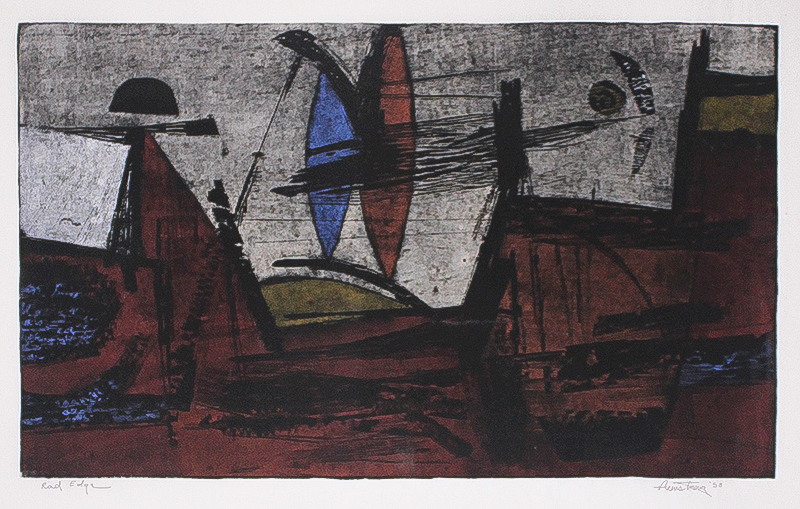Red Edge is color woodcut created in 1958 by American artist, Bill Howard Armstrong. It is pencil signed, titled and dated. This impression is an uninscribed proof from a very small edition. Red Edge was printed by the artist on an ivory, fibrous wove paper. The image measures 17-1/4 x 23-3/4 inches.
This color woodcut was originally issued in 1954 as Blue Move. An impression of Blue Move in the Brooklyn Museum is pencil signed, titled, dated, and editioned 7/7. Red Edge is a color variant. In a letter to Daniel Lienau of The Annex Galleries, Armstrong wrote: “I’ve included a student print of Tom Fricano’s. He got me interested in wood cuts and probably has a mountain of work from this period. I thought that their [sic] were all too many printmakers at the time and watercolor was being neglected, so I went where I was needed.”
Bill Howard Armstrong, printmaker, painter, illustrator, and educator, was born in Horton, Kansas on 13 December 1926 to Pearl Marion and Elise Nettie Brown Armstrong. He attended Woodruff High School in Peoria, Illinois graduating in 1944. Armstrong enlisted in the United States Air Cadet Training Program, 1944-1945, and served in Manilla. Following his military discharge, he studied at Bradley University in Peoria and received his BFA degree (cum laude) in 1949. Armstrong continued his education at the University of Illinois at Urbana under Abraham Rattner and received his MFA in 1955.
Armstrong’s teaching career began in 1955 when he was hired as an assistant professor in the art department at the University of Wisconsin at Madison. While there he was selected by the Ford Foundation to be an art consultant to the Burma Translation Society in Rangoon. During his stay in Burma, he also worked with UNESCO to organize and conduct seminars for publishers from five Southeast Asian countries. In 1963 he was recruited by Southwest Missouri State University at Springfield to set up their graphic arts department. He spent his career at Southwest Missouri State University where he also taught drawing, painting, and art history classes until his retirement in 1988.
Aside from teaching and the creation and promotion of his own art, Armstrong was a freelance illustrator whose illustrations enriched at least eleven books.
Armstrong’s work was included in numerous national invitational exhibitions and was featured in international exhibitions via the American Federation of Arts and the Society of American Graphic Artists. He was a member of the Alabama Watercolor Society, the Boston Printmakers, the National Watercolor Society, the Philadelphia Watercolor Club, the Society of American Graphic Artists, and the Missouri Arts Council Visual Arts Advisory Committee. He was a founder and honorary president of Watercolor U.S.A. Honor Society and was given a Lifetime Achievement award from the group in 2006. Armstrong was also a recipient of the Missouri Arts Council’s Achievement Trophy (Missouri’s highest honor for lifetime contribution to the arts) in 1990; an Ozzie award from the Springfield Area Arts Council in 2003; and an Appreciation award, Missouri State University Alumni in 2005.
Bill Howard Armstrong’s work is represented in the collections of the Brooklyn Museum, New York; and the Springfield Art Museum, Illinois.
William (Bill) Howard Armstrong died on 25 August 2016 in Springfield, Missouri.



